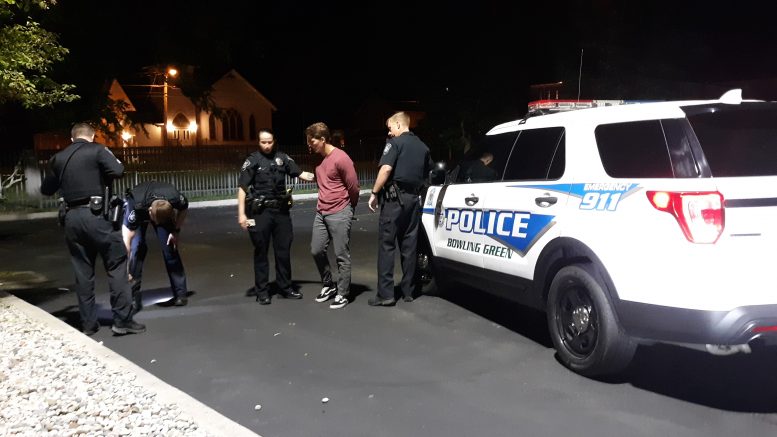By JAN LARSON McLAUGHLIN
BG Independent News
Local law enforcement is trying to weed through the last minute changes made to Ohio’s recreational marijuana law, which went into effect today.
The state’s voters solidly supported Issue 2 by 57% in November – but the State Senate was debating the rules right up until Wednesday night.
“We’re still sorting through it now,” Bowling Green Police Lt. Adam Skaff said Thursday morning, after reviewing instructions for enforcement from the city prosecutor.
“This is extremely difficult,” to properly enforce a moving target, he said. “Like anything, there’s growing pains. We’ll do our best to enforce it properly. We’ll be in constant communication with the prosecutor’s office.”
New rules still changing
As recently as this past weekend, Bowling Green Police Division was citing violators for marijuana use. This year, from January through October, BGPD made 168 drug arrests – with an estimated 90% being marijana charges, Skaff said.
But that all changed today – kind of.
Under the new law, people 21 and older can use and grow marijuana for recreational purposes – with some caveats.
There are still rules regulating marijuana. As for use in public areas, marijuana will be treated somewhat like alcohol, Skaff said.
- Users must be 21 or older.
- Drivers – and passengers – cannot smoke in a vehicle while it’s being used or when it would impede the driver’s ability.
- The amount and THC levels are regulated.
- Marijuana cannot be smoked in public areas – similar to open container laws for alcohol.
“We interpret the law to not allow smoking of marijuana on sidewalks,” Skaff said. “This may change.”
Skaff’s advice for people using marijuana is to stay off the roads.
“Just don’t operate a vehicle,” he said.
City Attorney won’t recommend tougher laws for BG
Some communities have already taken steps to limit the use and growing of recreational marijuana in their jurisdictions.
“Cities can always be more restrictive,” Skaff said.
However, Bowling Green City Attorney Hunter Brown said he is not recommending that the city enact further regulations for marijuana.
“We should not, as a municipality, prohibit it for a variety of reasons,” Brown said Thursday evening. “Most importantly, I do not wish to contradict the overwhelming will of the voters.”
If the state grants cities the power to use home rule to ban marijuana, “I am going to highly, highly recommend against doing that,” Brown said.
Earlier in the day, the city administration issued a memo stating the city policy is still that employees should not be using recreational marijuana given that it’s still illegal at the federal level.
“I do plan on having the city revisit this policy soon,” Brown said.
Enforcement – no easy breath test
Unlike drivers suspected to be under the influence of alcohol, there is no easy breath test to determine if marijuana has been used. And many of the field tests, like walking in a straight line, are not effective at determining marijuana use, and not easily done alongside the road, Skaff said.
Three Bowling Green police officers have gone to training to learn the indicators for drug use. The “enhanced drug recognition” training allows them to note common indicators of marijuana use, such as dilated pupils, euphoria, impaired perception of time and distance, drowsiness, impaired memory, and lack of concentration.
Skaff said he expects more officers to be sent away for that training.
Urine and blood tests can prove marijuana use. The tests will be sent to state labs, with the state picking up the costs, at least for now.
Skaff cautioned that marijuana remains present in a body longer than alcohol. So officers will need to determine impairment – not just presence in the body.
“Alcohol leaves the body much faster,” he said. “If I smoked marijuana yesterday, it will still be there today,” even if it’s no longer causing impairment.
Homegrown regulations
Issue 2 also allows Ohioans to grow their own marijuana.
People 21 and older can grow six plants per person with 12 plants per residence. As another example of the law changing day by day, the home grown provision had previously been eliminated earlier this week, but was brought back in the substitute bill.
In another change, Issue 2’s language had a 10% tax at the point of sale for each transaction. The bill would change the tax rate to 15% and eliminate the cultivators tax that was proposed earlier this week. The bill would also allow for local governments to levy an additional tax on top of the marijuana excise tax of 3%.
Possession limits would remain the same as originally proposed, at 2.5 ounces. And the THC levels would stay the same at 35% for plant material and reduce it from 90% to 50% for extracts. The number of dispensaries allowed at once would also remain at 350.
For those people previously charged with marijuana infractions, there would also be automatic expungements of records for those found in possession of 2.5 ounces or less.
Two dispensaries in BG
Originally, the dispensary sales for recreational marijuana were going to take effect in nine months. But, under the Senate bill, Ohioans can go to a dispensary and buy recreational products immediately.
Bowling Green has two marijuana dispensaries: Zen Leaf at 1155 N. Main St., and Nectar at 1011 S. Main St.
Skaff said ever since medical marijuana was permitted in Ohio, local law enforcement has often been criticized for charging people for possessing recreational marijuana. But the police were just doing their jobs, he said.
“We do what the law tells us to do,” Skaff said. “It’s been frustrating for us.”
Skaff suspects the recreational marijuana law will take lots of tweaking before the state irons out all of the wrinkles.
“It’s going to be a work in progress,” he said.

